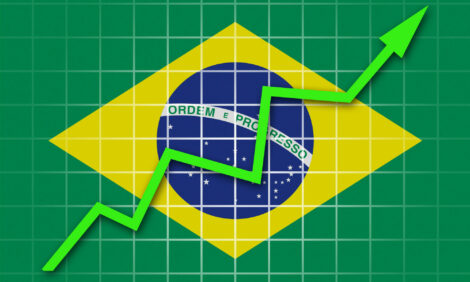



South Africa Faces Worst Drought in Thirty Years
SOUTH AFRICA - South Africa will be facing a disaster if it doesn’t rain by the end of December. Over the past year, El Niño has caused below average rainfall in many parts of the country, with some areas recording their lowest rainfall in fifty years. Dry climatic conditions is taking its toll on animal production and is threatening food security in the country. Glenneis Kriel reports.Dry climatic conditions, caused by El Niño, are having a decimating impact on agricultural production in South Africa and threatening to drive up food prices to unaffordable levels over the next few months.
It has resulted in total maize production (for animal and human consumption) falling from a record high of 14,25 million tons during the 2014/2015 season to an estimated 9,94 million tons for the current season that will come to an end in April 2016.
According to the South African Supply and Demand Estimates, the country, which under normal conditions are a net exporter of maize, would have to import 980,000 tons of maize to make up for the short fall this season.
The outlook for the 2016/2017 season isn’t much better. There has been scattered rainfall in various parts of the summer rainfall areas, but it has not been enough to break the drought. So far government has declared five provinces, KwaZulu-Natal, Mpumalanga, North West, Limpopo and Free State as drought disaster areas.
A bleak outlook for maize
Wandile Sihlobe, economist at Grain SA, said farmers on the Eastern side of the country in Mpumalanga are almost done planting, while the farmers in the Eastern Free State are more than half way through planting. On the Western side, the situation is looking dire. Most farmers are waiting for rain to plant, with the farmers in the North Western province only 10 per cent through their plantings.
The next three weeks will be critical: “Farmers on the Eastern side need follow-up rain, while the farmers on the Western side will need rain to plant within the next three weeks. After December, it will be too late for them to plant,” Mr Sihlobe said.
It is still too early to make crop estimates, but the general perception is that the country is heading for another below average harvest. Wessel Lemmer, senior agriculturist at Absa bank, said that El Niño conditions were expected to last until April 2016.
Hence there was little chance of the country receiving enough rain to replenish soil moisture levels or fill dams to their full capacity. At the time this article was written dam levels stood at 61 per cent of their capacity in comparison with 79 per cent this time last year.
Mr Lemmer, estimated that chances were less than 10 per cent that the country would be able to produce a normal yield during the 2016/2017 marketing season, but about 70 per cent to produce 9,8 million to 10,9 million tons, due to fewer hectares being planted and lower yields caused by the dry climatic conditions.
At these levels, South Africa will have to import another 880,000 to 2 million tons of maize next year. The worst case scenario is that production decline to 7,1 million tons, of which there is a 20 per cent chance. This, according to him, would result in the country having to import between 4 million to 5 million tons of maize.
Animal production
Dry climatic conditions has had a negative impact on pasture production and natural veld. It has also driven up feed prices, of which maize is one of the most important sources, by 50 per cent to 70 per cent.
Dr Koos Coetzee, chief economist at the Milk Producers Organisation in South Africa said that maize feed prices went up from about R2 600/ton (about 118 GBP/ton) this time last year to R3 400/ton (about 154 GBP/ton) this year, due to maize prices moving from export parity to import parity prices.
“The drought hasn’t had an impact on milk production yet, as production is currently 7,7 per cent higher for the 10 months up to October this year in comparison with what it was for the same period last year.
"There is nevertheless a shortage of roughage in many areas, which will limit milk production growth in the coming months. Higher grain prices in combination with lower milk prices, are also taking their toll on production and farm profitability margins,” Dr Coetzee said.
He pointed out that milk prices have come under pressure over the past few months, due to imports and higher local production caused by favourable production conditions. Dr Coetzee however foresees that imports will become unaffordable due to the weakening of the Rand against other major currencies.
Kevin Lovell, CEO of Poultry SA said that higher feed ingredient prices have not resulted in poultry producers downscaling production.
“Chances of this are quite slim, as poultry producers aren’t dependent on natural pastures or planted pastures for feed, as is the case with sheep and cattle farmers. Rising feed prices will however put farm margins under increased pressure, resulting in producers struggling to make money,” he said.
He hopes for the situation to change by March when predictions on the new maize harvest start to roll in. Retailers would, otherwise, have to raise prices significantly to compensate for higher feeding costs. This however would have a very negative impact on consumer expenditure, which is also already under pressure, according to him.
Mr Lovell wrote in his latest newsletter that the maize harvest was about 4 million tons (40 per cent) lower than the previous year. Total income from maize was about 1 billion Rand (about £48 million) less than the previous year, while consumer expenditure was however about 8 billion Rand (about £380 million) higher.
“It seems that consumers and livestock producers are carrying the brunt of cost of the poor harvest, while maize farmers who didn’t suffer crop failures had record financial years. On the other hand, it also seems as if speculators have been reaping the biggest advantage of these higher prices,” he said.
Gerhard Schutte, CEO of the Red Meat Producers Organisation, said that some areas in the country recorded their lowest rainfall in fifty years. In the KwaZulu-Natal province alone, more than 40,000 cattle has died and serious livestock losses are being experienced in the emerging sector country wide.
“Provision of water for livestock is now in a crisis situation, because water resources are drying up. New boreholes are being drilled at high costs and with limited success. In some cases water is trucked in as far as 15 kilometres,” he said.
He predicted that the water shortage in combination with high feeding costs will result in farmers reducing their nucleus herds with at least 5 per cent over the next few months. At 560,000 animal units most feedlots are however running at full capacity.
Mr Schutte said that it would take commercial red meat producers between three to four years to recover economically from the drought. The impact on small-scale and emerging producers will however be more severe.
He estimated that the drought will impact more than 1.2 million households that own cattle, sheep and goats and in effect have a serious impact on rural economies and food security.








